Standard [CURRENT]
ASTM D 4530:2025
Standard Test Method for Determination of Carbon Residue (Micro Method)
- German title
- Bestimmung des Mikrokohlenstoffrückstands von Mineralölerzeugnissen
- Publication date
- 2025
- Original language
- English
- Pages
- 7
- Publication date
- 2025
- Original language
- English
- Pages
- 7
- DOI
- https://dx.doi.org/10.1520/D4530-25
Product information on this site:
Quick delivery via download or delivery service
Buy securely with a credit card or pay upon receipt of invoice
All transactions are encrypted
Short description
1.1 This test method covers the determination of the amount of carbon residue (see Note 1 ) formed after evaporation and pyrolysis of petroleum materials under certain conditions and is intended to provide some indication of the relative coke forming tendency of such materials. 1.2 The test results are equivalent to the Conradson Carbon Residue test (see Test Method D189 ). Note 1: This procedure is a modification of the original method and apparatus for carbon residue of petroleum materials, where it has been demonstrated that thermogravimetry is another applicable technique. 2 However, it is the responsibility of the operator to establish operating conditions to obtain equivalent results when using thermogravimetry. 1.3 This test method is applicable to petroleum products that partially decompose on distillation at atmospheric pressure and was tested for carbon residue values of 0.10 % to 30 % (m/m). Samples expected to be below 0.10 % by weight (m/m) residue should be distilled to remove 90 % (V/V) of the flask charge (see Section 9 ). The 10 % bottoms remaining is then tested for carbon residue by this test method. 1.4 Ash-forming constituents, as defined by Test Method D482 , or non-volatile additives present in the sample will add to the carbon residue value and be included as part of the total carbon residue value reported. 1.5 Also in diesel fuel, the presence of alkyl nitrates, such as amyl nitrate, hexyl nitrate, or octyl nitrate, causes a higher carbon residue value than observed in untreated fuel, which may lead to erroneous conclusions as to the coke-forming propensity of the fuel. The presence of alkyl nitrate in the fuel may be detected by Test Method D4046 . 1.6 The values stated in SI units are to be regarded as standard. No other units of measurement are included in this standard. 1.6.1 Exception- 6.4 and 6.5 include inch-pound units. 1.7 WARNING -Mercury has been designated by many regulatory agencies as a hazardous substance that can cause serious medical issues. Mercury, or its vapor, has been demonstrated to be hazardous to health and corrosive to materials. Use Caution when handling mercury and mercury-containing products. See the applicable product Safety Data Sheet (SDS) for additional information. The potential exists that selling mercury or mercury-containing products, or both, is prohibited by local or national law. Users must determine legality of sales in their location. 1.8 This standard does not purport to address all of the safety concerns, if any, associated with its use. It is the responsibility of the user of this standard to establish appropriate safety, health, and environmental practices and to determine the applicability of regulatory limitations prior to use. For specific warning statements, see 8.2.3 and 8.4 . 1.9 This international standard was developed in accordance with internationally recognized principles on standardization established in the Decision on Principles for the Development of International Standards, Guides and Recommendations issued by the World Trade Organization Technical Barriers to Trade (TBT) Committee.
ICS
75.080
DOI
https://dx.doi.org/10.1520/D4530-25
Also available in
Loading recommended items...
Loading recommended items...
Loading recommended items...
Loading recommended items...

